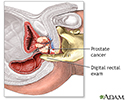Digital rectal exam
DRE
A digital rectal exam is an examination of the lower rectum. The health care provider uses a gloved, lubricated finger to check for any abnormal findings.
How the Test is Performed
The provider will first look at the outside of the anus for hemorrhoids or fissures. Then the provider will put on a glove and insert a lubricated finger into the rectum. In women, this exam may be done at the same time as a pelvic exam.
Hemorrhoids
Hemorrhoids are swollen veins in the anus or lower part of the rectum.

How to Prepare for the Test
For the test, the provider will ask you to:
- Try to relax
- Take a deep breath during the insertion of the finger into your rectum
How the Test will Feel
You may feel mild discomfort during this test.
Why the Test is Performed
This test is performed for many reasons. It may be done:
- As part of a routine yearly physical exam in both men and women
- When your provider suspects you are bleeding somewhere in your digestive tract
-
When men are having symptoms that suggest the
prostate is enlarged
or you may have a prostate infection
Prostate is enlarged
The prostate is a gland that produces the fluid that carries sperm during ejaculation. The prostate gland surrounds the urethra, the tube through wh...
 ImageRead Article Now Book Mark Article
ImageRead Article Now Book Mark Article
In men, the test can be used to check the size of the prostate and to look for abnormal bumps or other changes of the prostate gland.
A digital rectal exam may be done to collect stool for testing for fecal occult (hidden) blood as part of screening for cancer of the rectum or colon.
Fecal occult (hidden) blood
The stool guaiac test looks for hidden (occult) blood in a stool sample. It can find blood even if you cannot see it yourself. It is the most commo...

Normal Results
A normal finding means the provider did not detect any problem during the exam. However, this test does not rule out all problems.
What Abnormal Results Mean
An abnormal result may be due to:
-
A prostate problem, such as an
enlarged prostate gland
,
prostate infection
, or
prostate cancer
Enlarged prostate gland
The prostate is a gland that produces the fluid that carries sperm during ejaculation. The prostate gland surrounds the urethra, the tube through wh...
 ImageRead Article Now Book Mark Article
ImageRead Article Now Book Mark ArticleProstate infection
Prostatitis is swelling of the prostate gland. Prostate tissue becomes inflamed. This problem can be caused by an infection with bacteria. Acute pr...
 ImageRead Article Now Book Mark Article
ImageRead Article Now Book Mark ArticleProstate cancer
Prostate cancer is cancer that starts in the prostate gland. The prostate is a small, walnut-shaped structure that makes up part of a man's reproduc...
 ImageRead Article Now Book Mark Article
ImageRead Article Now Book Mark Article - Bleeding anywhere in the digestive tract
- Cancer of the rectum or colon
-
Small split or tear
in the thin moist tissue lining of the anus (called anal fissure)
Small split or tear
An anal fissure is a small split or tear in the thin moist tissue (mucosa) lining the lower rectum (anus).
 ImageRead Article Now Book Mark Article
ImageRead Article Now Book Mark Article -
An
abscess
, when pus collects in the area of the anus and rectum
Abscess
An anorectal abscess is a collection of pus in the area of the anus and rectum.
 ImageRead Article Now Book Mark Article
ImageRead Article Now Book Mark Article -
Hemorrhoids
, swollen veins in the anus or lower part of the rectum
Hemorrhoids
Hemorrhoids are swollen veins in the anus or lower part of the rectum.
 ImageRead Article Now Book Mark Article
ImageRead Article Now Book Mark Article
References
Abdelnaby A, Downs MJ. Diseases of the anorectum. In: Feldman M, Friedman LS, Brandt LJ, eds. Sleisenger and Fordtran's Gastrointestinal and Liver Disease . 9th ed. Philadelphia, PA: Elsevier Saunders; 2016:chap 129.
Loeb S, Carter HB. Early detection, diagnosis, and staging of prostate cancer. In: Wein AJ, ed. Campbell-Walsh Urology . 10th ed. Philadelphia, PA: Elsevier Saunders; 2012:chap 99.
-
Indications - illustration
Prostate cancer is the most common cancer in men in the United States. Prostate cancer forms in the prostate gland, and can sometimes be felt on digital rectal examination. This is one of the purposes of the digital rectal exam.
Indications
illustration
Review Date: 11/1/2015
Reviewed By: Linda J. Vorvick, MD, Medical Director and Director of Didactic Curriculum, MEDEX Northwest Division of Physician Assistant Studies, Department of Family Medicine, UW Medicine, School of Medicine, University of Washington, Seattle, WA. Also reviewed by David Zieve, MD, MHA, Isla Ogilvie, PhD, and the A.D.A.M. Editorial team.

